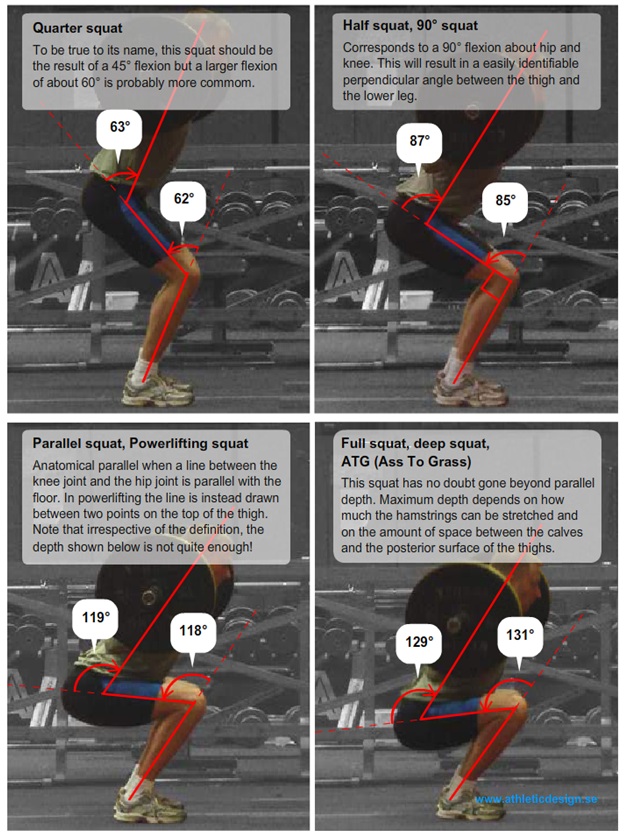As promised, today’s article will be all about Strengthening Exercises that you can do for the various muscle groups in your legs and torso. I’ve been training my legs ever since I started running, and whether you’re a runner, cyclist, swimmer, athlete, weight-lifter, sports person or even none of these, trust me you’ll thank yourself one day for all that muscle in your lower limbs. Having strong and muscular legs not only boosts athletic performance, but also makes movement during daily activities more efficient, and you’re less prone to your legs giving way or developing arthritis of the knees at an advanced age. And when It comes to lower body exercises, the squat is king. I swear by squats as the the only workout move you’re ever gonna need for your legs and lower back. I had a phase when I was regularly doing 100-150 squats a day, and I could most definitely see improvements in my athletic performance. But don’t just take my word for it! Here are a bunch of reasons why you should squat:
1. Builds Muscle in Your Entire Body
Squats obviously help to build your leg muscles (including your quadriceps, hamstrings, and calves), but they also create an anabolic environment, which promotes body-wide muscle building.
In fact, when done properly, squats are so intense that they trigger the release of testosterone and human growth hormone in your body, which are vital for muscle growth and will also help to improve muscle mass when you train other areas of your body aside from your legs. So squats can actually help you improve both your upper and lower body strength.
2. Functional Exercise Makes Real-Life Activities Easier
Functional exercises are those that help your body to perform real-life activities, as opposed to simply being able to operate pieces of gym equipment. Squats are one of the best functional exercises out there, as humans have been squatting since the hunter-gatherer days. When you perform squats, you build muscle and help your muscles work more efficiently, as well as promote mobility and balance. All of these benefits translate into your body moving more efficiently in the real world too.
3. Burn More Fat
One of the most time-efficient ways to burn more calories is actually to gain more muscle! For every pound of additional muscle you gain, your body will burn an additional 50-70 calories per day. So, if you gain 10 pounds of muscle, you will automatically burn 500-700 more calories per day than you did before.
4. Maintain Mobility and Balance
Strong legs are crucial for staying mobile as you get older, and squats are phenomenal for increasing leg strength. They also work out your core, stabilizing muscles, which will help you to maintain balance, while also improving the communication between your brain and your muscle groups, which helps prevent falls – which is incidentally the #1 way to prevent bone fractures versus consuming mega-dose calcium supplements and bone
5. Prevent Injuries
Most athletic injuries involve weak stabilizer muscles, ligaments and connective tissues, which squats help strengthen. They also help prevent injury by improving your flexibility (squats improve the range of motion in your ankles and hips) and balance, as noted above.
6. Boost Your Sports Performance — Jump Higher and Run Faster
Whether you’re a weekend warrior or a mom who chases after a toddler, you’ll be interested to know that studies have linked squatting strength with athletic ability.1 Specifically, squatting helped athletes run faster and jump higher, which is why this exercise is part of virtually every professional athlete’s training program.
7. Tone Your Backside, Abs and Entire Body
Few exercises work as many muscles as the squat, so it’s an excellent multi-purpose activity useful for toning and tightening your behind, abs, and, of course, your legs. Furthermore, squats build your muscles, and these muscles participate in the regulation of glucose and lipid metabolism and insulin sensitivity, helping to protect you against obesity, diabetes and cardiovascular disease.
I hope I’ve convinced you of my argument. Now let’s get into how you can do a squat perfectly, so as to achieve the most out of this wonderful exercise (Before starting any exercise regimen, it’s very important that you consult your doctor or physician, especially after a major surgery or while recovering from an injury):
Remember the following form tips
- As you lower your torso, remember to stick your butt out, keep your chest up and keep your face looking straight ahead (imagine sitting down on an imaginary chair)
- Lower yourself slowly. You should take 3 seconds to lower your torso, no faster. Breathe in deep.
- When you’ve reached the lowest comfortable point while squatting, hold position for a second, clench your buttocks and imagine you’re using only your buttocks to push your torso back up, while pushing your weight through your heels, not your toes.
- One of the check points of a perfect squat are that at any point during the squat, you should be able to wiggle your toes. This means that all your bodyweight is being transferred to the ground via your heels.
- It should take you 3 seconds to come back up, no faster than that. Breathe out slowly.
- Take care to ensure your knees don’t buckle inward towards your groin and are pointed away from the groin always.
And that’s all there is to the perfect squat!
Now the next question that comes to mind is How low should you squat? Here’s a bit of detail about the bio mechanics of the squat:

The first phase of the squat is characterized by the anterior chain dominance. In other words these are the muscles on the front of your thigh, between the hips and the knee(the quadriceps). In this case the anterior chain does all the work. If you follow with your hand the distance between the front side of your hips , down to the knee, this will be your quadriceps tendon. A little further down this “route” is the tendon of your patella(knee cap). When you get to the “sticking” bone on the side of your knee, you will be to the point where that tendon attaches to your shin(also called tibia).
When you do half squats the anterior chain is under tension. The tendon of your patella, pulls the tibia, which is followed by a slide forward, which results in a grind against your thigh’s bone(femur). The consequence is the uneven load on the bones of your knee. The result could be a bad injury!
I guess that because most people are doing half squats instead of full squats, the squat received the bad fame of being a dangerous movement!
What happens if we make the effort to learn the right technique of the full squat and start squatting deeper? In this case, you will activate not only your anterior chain but also the posterior chain( the muscles on the back of your upper leg). Now you are loading the front group muscles, together with the back group of muscles and the load is even!
The hamstrings have the opposite effect of the quadriceps and oppose to the shear force of the anterior chain. Thus, occurs a balance between the force produced by the anterior and the posterior chain.
The full squat is a natural human posture often used as an alternative to sitting in Asian cultures and among young children, but rarely performed by adults in Westernized countries. Spending time in a squat position offers many health benefits and can serve as way to correct postural imbalances. Squatting is a safe activity when performed properly. Someone who is healthy and in relatively good physical shape without a history of knee injuries should be able to squat safely with minimal risk. Individuals with a history of knee injury need to give consideration to the increased forces placed on the structures of the knee when squatting. A lack of ankle mobility is usually the limiting factor that would prevent an individual from reaching full depth. The ability to do a full depth squat is a sign of good physical health.
If you think you’ve mastered the simple squat, then here are some of the more advanced variations on that:
Here you’ll find a bunch of exercises other than the squat to build muscle in your lower body. Mix up your routine with these exercises to keep things interesting or to avoid hitting a plateau in your growth and strength.
One thing I would definitely advise you to do is functional exercise. Functional fitness exercises train your muscles to work together and prepare them for daily tasks by simulating common movements you might do at home, at work or in sports. While using various muscles in the upper and lower body at the same time, functional fitness exercises also emphasize core stability. For example, a squat is a functional exercise because it trains the muscles used when you rise up and down from a chair or pick up low objects. By training your muscles to work the way they do in everyday tasks, you prepare your body to perform well in a variety of common situations.
Functional exercises tend to use multiple joints and numerous muscles. Instead of only moving the elbows, for example, a functional exercise might involve the elbows, shoulders, spine, hips, knees and ankles. This type of training, properly applied, can make everyday activities easier, reduce your risk of injury and improve your quality of life.
Here are some functional exercises for you to try out:
Here you’ll find how to mix up the exercises demonstrated above in your workout routine.
However, if you’ve been working out regularly, if you think your legs are strong enough, and are looking to work just one or two particular muscle groups, here are the exercises that specifically target a certain group:
Quads
Hamstrings
- Bodyweight
- Weighted
Glutes
Calves
- Bodyweight (while doing calf raises, if you point your toes outward, you work the outer calf (gastrocnemius), and if you point the toes inward, you work the inner calf (soleus)
- Weighted
Hip Flexors
Shin
Adductors (inner thigh)
Abductors (outer thigh)
As always, if you liked this article, please go like our Facebook Page and also that of the soon-to-be conducted first ever Manipal Marathon. More details in the upcoming weeks!
(text source: Mercola Fitness, inspiredfitstrong, somastruct, mayo clinic)


Be the first to comment